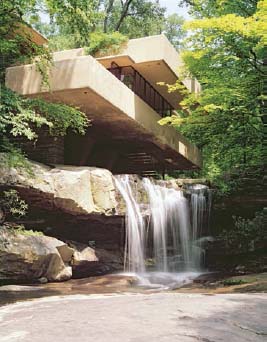The Modern World During and After the World Wars, C. 1914–1960Architecture and Design |
Who was Frank Lloyd Wright? |
Frank Lloyd Wright (1867–1959) was a famous American architect whose decorative aesthetic continues to be immensely popular and well-respected today. Wright’s career began in Chicago, Illinois, where he worked first for Joseph Lyman Silsbee and later Adler and Sullivan (Louis Sullivan was one of Wright’s greatest inspirations). Wright is most closely associated with domestic architecture, known as his “Prairie School” houses. Wright’s designs for houses, such as Robie House (1907–1909) in Chicago, are characterized by long horizontal forms, open floor plans, overhanging eaves, use of natural materials, and integration with the flat landscapes of the Midwest. Like other architects working in the early twentieth century, Wright was interested in developing a unified architecture; but, he also believed in what he called “organic architecture.” For Wright, this meant that he was concerned with designing a structure, as well as designing it’s interior, furniture, and landscape to create an integrated whole. Some of Wright’s most famous projects include Falling Water, built into the rocky landscape of Mill Run, Pennsylvania, in 1935, and the curving Solomon R. Guggenheim Museum in New York, which opened just after Wright’s death in 1959.

American architect Frank Lloyd Wright designed this house, Falling Water, for the Kaufmann family in 1935 in rural Pennsylvania. The house was built over a waterfall and was intended to mirror the natural environment. (Art © 2013 Frank Lloyd Wright Foundation, Scottsdale, AZ / Artists Rights Society [ARS], NY)
